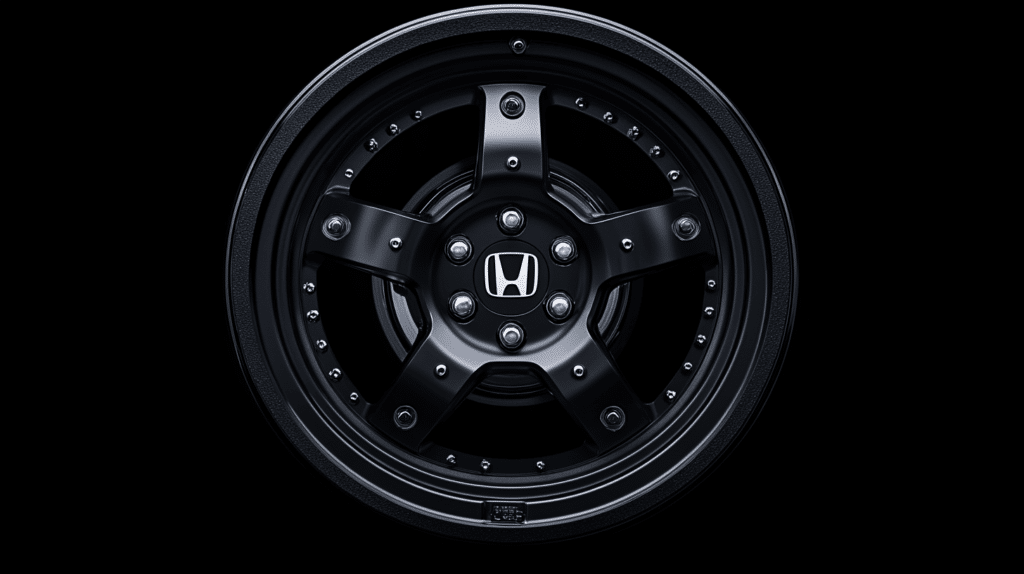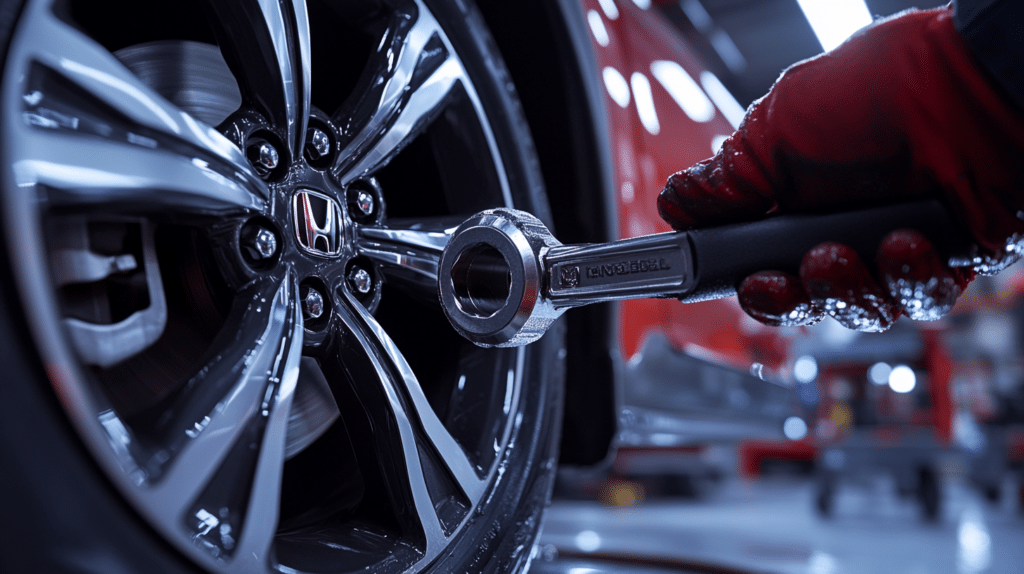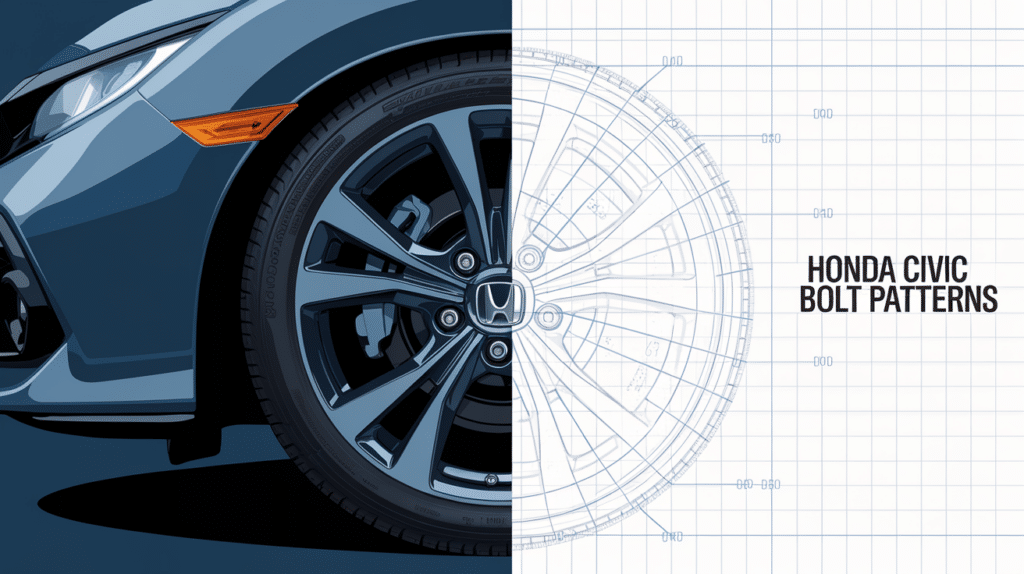Want to know something odd? The right bolt pattern can make or break your Honda Civic’s wheel setup.
I’ve seen many car owners waste hundreds of dollars on wheels that don’t fit their Civic because they didn’t check the bolt pattern first.
It’s frustrating to deal with returns or modifications after buying the wrong wheels.
But here’s the good news – I’ll show you everything about Honda Civic bolt patterns in simple terms.
I’ve spent years working with different Civic models, and I know exactly what to look for when matching wheels to these cars.
By the end of this blog, you’ll know how to pick the perfect wheels for your Civic without any costly mistakes.
What Is the Bolt Pattern for A Honda Civic?

- A bolt pattern, also called a lug pattern, refers to the arrangement of lug holes on a wheel.
- It is expressed as a two-part measurement, such as 4×100 or 5×114.3.
- The first number indicates the number of lug holes, while the second number specifies the diameter (in millimeters) of the circle formed by these holes.
The Honda Civic typically features the following bolt patterns:
- Older models, such as those from 1988 to 2005, generally use a 4×100 mm bolt pattern.
- More recent models, starting from 2006 onwards, have shifted to a 5×114.3 mm bolt pattern.
Why Bolt Patterns Matter?
- Proper bolt patterns ensure secure mounting, minimizing the risk of wheel wobbling or detachment.
- Mismatched patterns can lead to unsafe driving conditions and damage to the wheel hub assembly.
- Correct bolt patterns maintain the alignment and balance of the wheels, enhancing vehicle stability and handling.
- Ensuring the right bolt pattern prevents unnecessary wear and tear on suspension components, extending their lifespan.
Key Considerations:
- The 4×100 pattern was standard in earlier models, transitioning to 5×114.3 for better wheel stability and fitment in later generations.
- The Type R uses a unique 5×120 pattern, distinct from other trims.
- Always confirm your specific model’s bolt pattern before purchasing wheels.
Everything You Need to Know About Honda Civic Bolt Pattern’s Compatibility

1. Generational Compatibility
- Early models like the 1988–2000 Civic feature a 4×100 bolt pattern, which is common in compact vehicles of that era.
- From 2006 onward, most Civics (except Type R) transitioned to a 5×114.3 pattern, offering better stability and support for larger wheels.
- The Type R models (2017–2025) adopted a unique 5×120 bolt pattern designed for high-performance wheels with enhanced handling capabilities.
2. Additional Compatibility Considerations
- Tire Size: Ensure the chosen wheels are compatible with tires that maintain the correct overall diameter to avoid issues with the speedometer and ABS functionality.
- Backspacing: Check the backspacing of the wheels to ensure they provide enough clearance for brake calipers and suspension components.
- Load Rating: Select wheels with a load rating that meets or exceeds the weight capacity of your Honda Civic for safe and reliable performance.
- Material and Construction: Opt for wheels made of durable materials, such as aluminum alloy, to balance strength and weight for better handling and fuel efficiency.
PLUS: Tips for Upgrading Wheels
- Verify the bolt pattern and offset in the owner’s manual or by consulting a professional.
- Ensure aftermarket wheels match the bolt pattern and specifications of the specific Civic trim.
- Choose wheels with the appropriate diameter and width to maintain proper clearance and avoid interference with brake components.
- Opt for high-quality, lightweight materials to improve performance, fuel efficiency, and overall handling.
By understanding Honda Civic bolt patterns and their compatibility, you can confidently select wheels that enhance performance, maintain safety, and elevate the style of your vehicle.
Bolt Pattern for Different Honda Models
| Model Year | Trim | Bolt Pattern | Wheel Size Range | Offset Range |
|---|---|---|---|---|
| 1988–2000 | All Trims | 4×100 | 14×5.5 to 17×7.5 | +35mm to +45mm |
| 2001–2005 (Except Si) | Standard Trims | 4×100 | 14×5.5 to 17×7.5 | +35mm to +45mm |
| 2004–2005 Si Models | Si | 5×114.3 | 16×6.5 to 18×8 | +35mm to +45mm |
| 2006–2015 (All Except Si) | Standard Trims | 5×114.3 | 16×6.5 to 19×8.5 | +38mm to +48mm |
| 2006–2015 Si | Si | 5×114.3 | 17×7 to 19×8.5 | +38mm to +48mm |
| 2016–2021 (All Except Type R) | Standard Trims | 5×114.3 | 16×7 to 19×8.5 | +35mm to +48mm |
| 2017–2021 Type R | Type R | 5×120 | 19×8.5 to 20×9.5 | +45mm to +60mm |
| 2017–2020 Si | Si | 5×114.3 | 18×8 to 20×9 | +40mm to +55mm |
| 2022–2025 (All Except Type R) | Standard Trims | 5×114.3 | 16×7 to 19×8.5 | +35mm to +48mm |
| 2023–2025 Type R | Type R | 5×120 | 18×9 to 20×10 | +45mm to +60mm |
How To Identify the Correct Bolt Pattern for A Specific Honda Model
identifying the correct bolt pattern for your Honda model is essential for selecting compatible wheels.
Follow these steps to determine the bolt pattern accurately:
Step 1: Understand the Bolt Pattern Format:
The bolt pattern is expressed as XxY, where:
- X: Number of lug holes (e.g., 4 or 5).
- Y: Diameter of the circle formed by the lug holes, measured in millimeters (e.g., 100 or 114.3).
Step 2: Check the Vehicle’s Documentation:
Refer to the owner’s manual or the vehicle’s specifications for the factory bolt pattern.
Step 3: Count the Number of Lug Holes:
- Identify whether your model has 4, 5, or more lug holes.
- Example: A Honda Civic from 1988–2000 typically has 4 lugs, while 2006–2025 models generally feature 5 lugs.
Step 4: Measure the Circle Diameter:
- For 4-lug wheels: Measure from the center of one lug hole to the center of the opposite hole.
- For 5-lug wheels: Measure from the back edge of one lug hole to the center of the farthest lug hole.
Step 5: Refer to Honda Civic Model Specific Patterns:
Based on the generation and trim:
- 1988–2000: Bolt pattern is 4×100.
- 2006–2025 (Most Models): Bolt pattern is 5×114.3.
- Type R Models (2017–2025): The bolt pattern is 5×120.
Step 6: Consult Bolt Pattern Charts:
Use reference charts like the one in this guide to confirm the bolt pattern specific to your model year and trim.
Seek Professional Help When Needed
If unsure, consult a mechanic or wheel specialist who can measure and confirm the bolt pattern for your specific Honda model.
By following these steps, you can accurately identify the correct bolt pattern, ensuring the safe and proper fitment of wheels.
Comparisons Between Honda Civic and Other Brands’ Bolt Patterns
| Brand/Model | Year Range | Bolt Pattern | Notes |
|---|---|---|---|
| Honda Civic | 1988–2000 | 4×100 | Standard bolt pattern for older Civics. |
| Honda Civic | 2001–2005 | 4×100 (except Si) | Maintained for most trims; Si switched to 5×114.3. |
| Honda Civic | 2006–2025 | 5×114.3 | Widely adopted for modern Civics. |
| Honda Civic Type R | 2017–2025 | 5×120 | Performance-oriented bolt pattern. |
| Toyota Corolla | 1988–2025 | 4×100/5×114.3 | Older models share similarities with Civic. |
| Mazda 3 | 2003–2025 | 5×114.3 | It Matches the Honda Civic’s modern bolt pattern. |
| Nissan Altima | 2002–2025 | 5×114.3 | It is the same as the Civic; it ensures cross-compatibility. |
| Subaru Impreza | 1992–2025 | 5×100/5×114.3 | Varies by generation, similar to Civic trims. |
| Volkswagen Golf/GTI | 1990–2025 | 5×112 | Different bolt pattern compared to Civics. |
| Ford Focus | 2000–2025 | 4×108/5×108 | Unique bolt pattern compared to Civic models. |
| Hyundai Elantra | 2001–2025 | 4×114.3/5×114.3 | Matches Civic in some models. |
| Kia Forte | 2010–2025 | 5×114.3 | Compatible with modern Civic bolt patterns. |
Tips for Maintaining Optimal Torque for Your Civic’s Bolt Pattern

Maintaining the correct torque on your Honda Civic’s bolt pattern is essential for wheel safety, performance, and longevity.
Improper torque can lead to wheel misalignment, vibration, or even dangerous driving conditions.
Key Tips for Maintaining Optimal Torque:
- Tighten lug nuts to the recommended torque specification (80 lb-ft) using a torque wrench for accuracy.
- Follow a criss-cross tightening pattern to ensure even pressure across the wheel hub.
- Recheck and re-torque lug nuts after driving 100 miles post-installation to prevent loosening.
- Avoid over-tightening, as it can damage the lug nuts, wheel studs, or the bolt pattern itself.
- Inspect lug nuts and wheel studs for wear, rust, or damage before tightening.
- Use only high-quality, compatible lug nuts for aftermarket wheels, as factory ones may not fit.
- Avoid using impact wrenches for final tightening, as they can exceed the recommended torque.
- Regularly clean the wheel hub and bolt area to prevent rust buildup and ensure proper fitment.
How To Maintain Bolt Patterns on Your Honda Civic
Maintaining the correct bolt pattern on your Honda Civic is crucial for safety, performance, and longevity. Proper care ensures your wheels fit securely and avoids issues like misalignment or uneven stress.
-
Regular Inspection: Check the wheels and lug nuts periodically for any damage or wear.
-
Torque Specifications: Ensure lug nuts are tightened to the recommended torque, usually around 80 lb-ft for Civics.
-
Cross-Pattern Tightening: Always tighten lug nuts in a criss-cross pattern to prevent uneven stress.
-
Use Compatible Wheels: Stick to wheels with the correct bolt pattern (e.g., 4×100 or 5×114.3) for your Civic model.
-
Clean Hub Surfaces: Remove dirt and corrosion from the hub before mounting wheels to ensure a proper fit.
-
Avoid Over-Tightening: Over-tightening lug nuts can damage threads and distort the bolt pattern alignment.
-
Check Lug Nut Condition: Replace worn or stripped lug nuts promptly to maintain bolt pattern integrity.
-
Proper Storage: Store removed wheels in a clean, dry area to prevent rust or deformation of bolt holes.
-
Use Quality Aftermarket Parts: Choose high-quality aftermarket wheels and lug nuts to ensure they match Civic specifications.
-
Professional Alignment: Have your wheels professionally aligned and balanced to prevent strain on the bolt pattern
Conclusion
Picking the right bolt pattern for your Honda Civic doesn’t have to be hard.
Remember to check your car’s model year and measure the pattern if you’re unsure. The right fit keeps your wheels secure and your car safe on the road.
A proper bolt pattern match saves you time and money and keeps you safe on the road.
With these basics in mind, you’re ready to make smart choices for your Civic’s wheels.
If you found this helpful, I have other easy-to-follow guides about bolt patterns for different cars. Take a look at my guides for:
- Honda CRV
- Volkswagen
- Ford Focus


